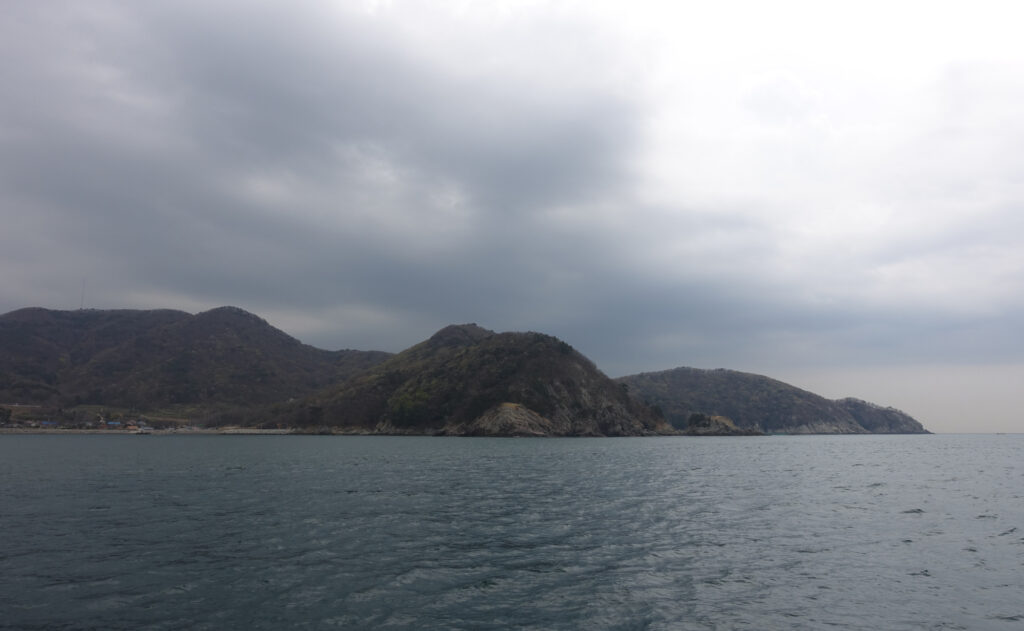Pre-Survey Visit to the Site of the “Proposed New Busan Airport” on Gadeok Island, Busan.
Dr Nial Moores, Director, Birds Korea
On March 27th 2021, at the invitation of General Secretary Kim Choony of the Korean Federation of Environmental Movements (KFEM), I visited the site of the proposed new Busan airport on Gadeok Island along with representatives from several KFEM local offices and additional KFEM committee members.
The proposed airport construction site is a narrow valley between two forested hills on a peninsula that edges the southwest of the very outer part of the Nakdong Estuary.


As currently proposed, construction would require the relocation of the local inhabitants from the village shown in the image above; the leveling of some of the hill slopes; and a runway protruding long and deep into the sea, lying atop many meters of estuarine sediments. Cost estimates seem to vary hugely for what appears likely to be one of the nation’s largest infrastructure undertakings since the ecologically-disastrous Saemangeum reclamation and Four Rivers projects. Although this site had previously been rejected several times, approval this time appears to have been facilitated by a combination of mayoral and national politics, and Busan city’s holding of the 2030 World Expo. This resulted in the passage of a special law in February, aimed at expediting project review and the start of construction.
As Birds Korea is a non-political NGO without specialist knowledge of construction and / or engineering, and with no expertise in predicting the amount of additional greenhouse gas emissions to be generated by construction (which will require the “removal” of several hills) and operation of a second airport serving the city, our commentary here will remain firmly focused on identifying possible impacts to biodiversity, especially birds, in the expectation that this will be of some help both to decision-makers and to other NGOs.
Based on research conducted by local people supported by experts, forest to be affected by the airport construction holds several breeding pairs of globally Vulnerable Fairy Pitta 팔색조 and globally Near Threatened Black Paradise Flycatcher 긴꼬리딱새.
Large parts of the forest are currently inaccessible, however. As seen from the boat travelling along the western shore of the headland, these forests look diverse and healthy, and likely to hold several more pairs of Fairy Pitta 팔색조 and perhaps other “Japanese species” (such as Japanese Night Heron 붉은해오라기, which has previously also been found nesting in Busan, and Black Woodpigeon 흑비둘기, which has been recorded several times in Busan, including once in the summer).

During less than three hours of opportunistic survey, three Black Kite 솔개 and a Russet Sparrow 섬참새 (very locally distributed in the ROK) were seen and several singing Japanese Bush Warbler 섬휘파람새 were heard. Although the inshore waters on the western side of the peninsula are very disturbed, with many recreational fishers along the shoreline and a major shipping lane only 500m or so offshore, we still managed to see six or more globally Endangered Narrow-ridged Finless Porpoise 상괭이, a rapidly declining species of increasing global and national conservation concern, and one Red-throated Loon 아비. Research in 2016 found 127 individual Narrow-ridged Finless Porpoise in 24 pods in waters around Gadeok Island (Park et al. 2017); but we are unaware of any research within this area to determine numbers of wintering, breeding and passage seabirds.
Of additional note, there was also a small but steady stream of migrants which on this day at least were funneled by local geography. These included at least 26 Eurasian Sparrowhawk 새매, three Eastern Buzzard 말똥가리, two or three flocks of Eurasian Siskin 검은머리방울새 and three Barn Swallow 제비. Raptors appeared to arrive in the southeast of the island; gain height on a hill slope south of the proposed runaway, and then cross the runway area to access thermals on the next larger hill (with a peak of approximately 455m asl suggested by Google Earth). Based on their direction of flight and low altitude it seems most likely that these were birds arriving in Korea after departing Teima Do/ Tsushima, and undertaking a 60km long sea-crossing.

In addition, flocks of gulls also passed through the narrow valley at 50-100m above ground level, taking a short cut across land as they moved northeast along the south coast.
A full list of bird species recorded this visit is on eBird.
Much more research is required to determine the importance of this peninsula for migrating and breeding birds; and also to assess whether or not lines of migrating raptors and other species, as seen on March 27th, will likely pose a risk of bird-strike if the airport is constructed as proposed. As befitting one of the world’s leading economies, it is always hoped that detailed research, conducted by specialists throughout at least one year, will be conducted and analysed before any permissions are actually given for construction. Up to now, however, this has very sadly not been our experience – or the experience of any other organisations that we are in contact with.
More updates on this project are very likely to follow.
Reference
Park K-J., Yoon Y-G, Sin J-H., Sohn HS & Choi Y-M. 2017. Distribution and Seasonal Changes in Finless Porpoise Neophocaena asiaeorientalis Populations near Gadeok Island, Korea. Korean Journal Fish Aquatic Science 50(5), 561-566, 2017.
